- Offensive Techniques & Strategies
Strong Post Defense
What to Discover or Recall:
Being able to defend the post is crucial in basketball.
All players, regardless of size, must be prepared fundamentally to defend post ups.
There are three basic post areas to defend: Low post, Medium post and High Post.
Post defense is a team effort. Defender guarding the passer must exert the utmost pressure, and the Off Ball defenders must provide strong back side support.
Defenders guarding a high post should assume an aggressive pass denial position on ball side.
When a high post sets an On-Ball screen, the defense can combat it by using one of the seven (7) different techniques.
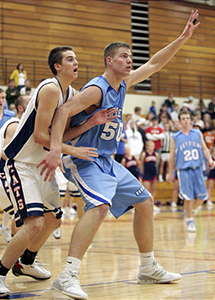
Posting up is a big part of the game of basketball. It is truly an advantage to have a dominant force inside. The most commonly used approach on how best to defend the post areas is for the defender to play behind or to the side of the offensive player, allowing the pass, and depending on fellow defenders for help that may or may not come. However, this makes little sense with today’s prolific inside scorers. A more aggressive approach is to deny and disrupt all passes into the post.
There are three basic post areas to defend: Low post, Medium post and High Post. When an offensive player assumes a low post position it is because they are a scorer. If the offensive player assumes a mid post position, they are a triple threat (shot, pass, drive), and when they assume a high post position they are most likely to be a screener or passer. It is very important that all defenders, not just the center, learn how to effectively pressure and deny the pass into all three post areas. In addition, posts also need to be well prepared to defend "On-Ball" screens as well as defensive transition.
| Post Deployment | Low Post Defense | Double Teams | High Post Defense | Post Transition | High Post Screens |

Mental Preparation: Analyzing Post Deployment
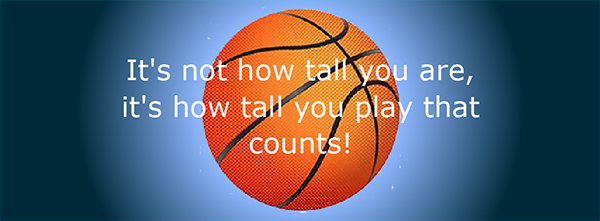
How best to defend the post will vary from player to player and game to game. Therefore, it is very important to analyze post deployment both before the game and during Game. If possible, scout the opponents before you play them. But, more importantly, be very attentive of post play during the game. Most offensive post players only have one or two moves. Therefore, be sure to analyze and take them away during the game.
Various Methods of Offensive Post Deployment include:
Primarily as a Scorer: Player will normally assume a low post position. Defender must deny and contest all post passes, and teammates must give support.
Primarily as a Screener: Try to deny or disrupt their on ball screen and rolls. Don't play "follow the leader." Communicate by verbally alerting and warning teammates of the screen.
Primarily as a Passer: Deny ball by pressuring the passing lane. Crowd and force the post into dribbling.
Primarily as a Driver: "Build Cushion" by playing off and push to the nearest pushpoint. Take an offensive charge whenever possible.
Primarily as a Cutter: Cutters can be difficult to defend. Play off and do not allow any direct cuts to the ball or basket.
Primarily as an Offensive Rebounder: Be careful in fronting a good offensive rebounder. Play behind or in a 3/4 pass denial position and push off the block.
Triple Threat Player: Fortunately, there are very few good "Triple Threat" (Shot, Drive & Pass) post players. Triple threat players are hard to guard and must receive support by their teammates.
Non-Player/Scorer Post Player: Do not guard a "Non-Player" post player. Defenders can play off and help teammates. In some cases, you may even want to encourage them to receive ball, and then deny all passing lanes.

Defending the Low Post
Being able to defend the low post area is crucial in basketball. Low post defense is not just limited to the tallest players on a team. On the contrary, smaller players can definitely expect to be posted up. Therefore, it is important that all players are skilled in the fundamentals of defending the post area.
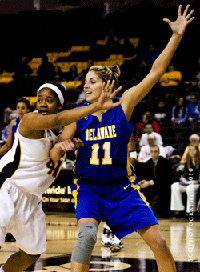
| Guidelines | Techniques | Changing Positions | Helpside | Defending Post with Ball |

Basic Post Defense Guidelines
1. Beat the offensive post to the "spot"
Post defense is played before the post receives the ball, not after. Force the opponent to adjust and set up out of their normal operating area. If the post wants to set up with back to basket in a low position, push high. If the offensive post likes to set up high, force low. Front and deny the passing lane against a good scoring post player. When playing behind the post, push off the block and away from basket.
2. Deny the post the ball
A defensive post must be determined to deny all post passes. Intimidate the offensive post by "standing one's ground" between the post and the potential passer. The defender's major mission in guarding the post, is to keep the ball from the opponent's hands. On a pass into the low post area, do not go for a steal unless backside help is available. When defending against the lob pass, go to a full chest (face), staying tight with both hands up high.
3. Play with agility and finesse rather than strength
Be active when defending against a post player. Stay low in an "Ear on Chest" pass denial position. Play with finesse, and do not lean on, wrestle or hug the post. Have "active" feet and do NOT get caught standing flat-footed. Defensive post must adjust position on every pass. Must vary defensive techniques. The offense will eventually adjust if only one defensive technique is employed during the game.
4. Play mentally tough
Assume an attitude of invincibility around the basket by taking charge with aggressive actions. A good defensive post must be aggressive and cannot be easily discouraged. Do not allow any uncontested cuts to the ball or the basket. Whenever possible take a charge. Disrupt or prevent any on ball post screens, and communicate on off ball screens. React quickly to a successful deflections, hustling and denying the opponent a chance to score off the loose ball. The defender's hard work should result in a turnover, not a successful recovery for the offense.
5. Total Team Effort
Defender guarding the player with the ball, must exert the utmost pressure taking away their shot and pass options and force the ball handler into dribbling. Off ball defenders must provide strong back side support.

Basic Low Post Defensive Techniques
1. Off Ball Strike Position
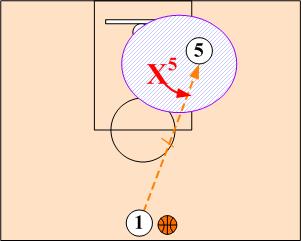
When the ball is in the middle of the floor at the point (Red Zone) the low post defenders assume a one step up the lane and one step off the lane "STRIKE" position.
2. Top Denial Position
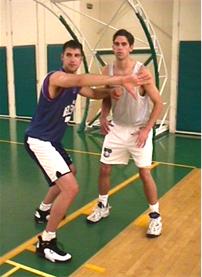
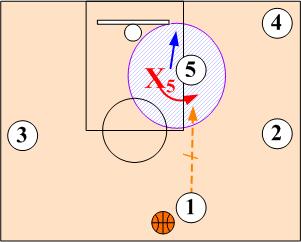
When ball is above the free throw line extended, post defender assumes a topside post pass denial position. The post defender assumes a low "Ear on Chest" 3/4 pass denial position Hand (STOP SIGN) extended out in the passing lane. Keep back foot 12" behind opponent's foot. Try to force the opponent below or off the block.
3. Post Front Position
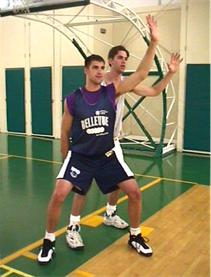
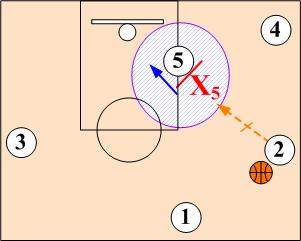
When the ball is on the wing, the post defender assumes a post front position. Lock up the post by sitting down on the opponent's thigh, keeping one arm extended high waving in the passing lane. Hold other arm low in contact with opponent's leg. Bend knees and force the opponent back into the three-second area. Keep the back foot 12" behind the opponent's foot in order to prevent the post from sealing off the defender for a reversal pass. This will also enable the defender to box out on any outside shot attempts. Use the post front to deny a good post the ball.
4. Base Denial Position
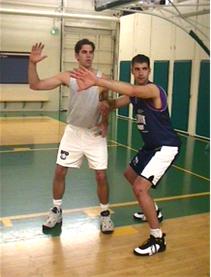
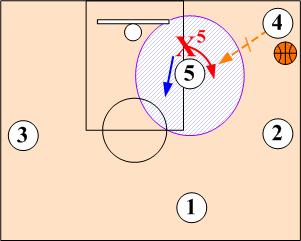
When the ball is in the corner, the post defender assumes a baseline pass denial position. Stay low "Ear on Chest" 3/4 pass baseline denial position with a hand (STOP SIGN) extended out in the passing lane. Keep back foot 12" behind opponent's foot. Try to push the opponent up the lane.
5. Play Behind Post
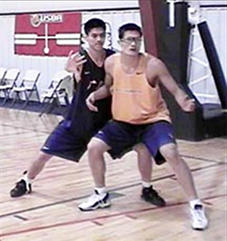
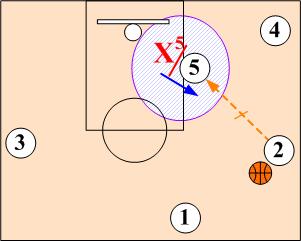
Playing behind a post up player can be effective in certain situations such as, when getting back late on defense, against a non-scoring post player, when double teaming, against a poor outside shooting team, against a good offensive rebounder, or when the defender is a dominate shot blocker. When playing behind the post, use an elbow high forearm in back and force the opponent off the block away from the basket. Extend and wave other arm into the passing lane.
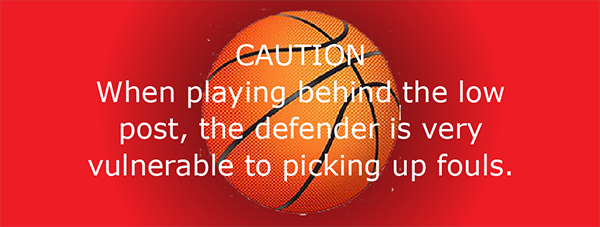
6. Post Face Position
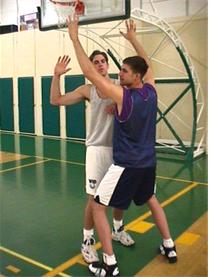
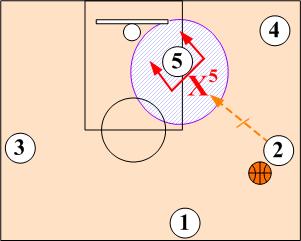
Post face position can be deployed to completely deny a great post the ball or when the post does not like physical contact. The defender assumes a full front, facing the post in a chest to chest position with both hands held high. Force the opponent into the lane. Maintain ball vision by looking back over the shoulder.
Defending the Post Lob
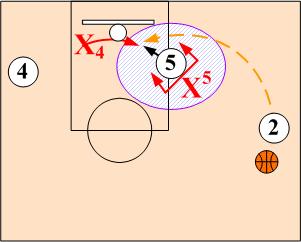
When the wing makes a lob pass into the post, the low post’s defender assumes a tight, full chest, face position with both hands held up high. The low helpside defender rotates over to take a charge or double team.

Methods for Changing Defensive Post Positions
In changing defensive positions on the post, the defender must read passer’s actions and move while ball is in the air. When the passer holds the ball high, the defender must defend passing lane. When the passer holds the ball low, be alert to adjust position for a drive. Release pressure whenever adjusting position. Step off, disengage and then quickly move to the desired new position. In adjusting defensive position on the post, defenders have the options of slip fronting, X-stepping, going behind or facing.
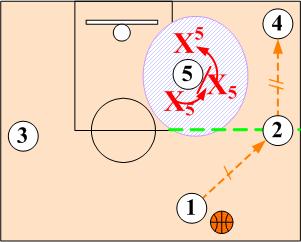
“Slip Front”
Move from a top pass denial contact position to a post front position to a baseline pass denial position. Change position as ball leaves the passer’s hands.
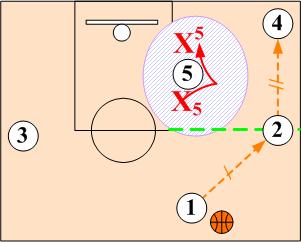
“X-Step”
Step in front by releasing contact and stepping over to a pass denial position on opposite side. Switch "Stop Signs" keeping a hand in the passing lane at all times.
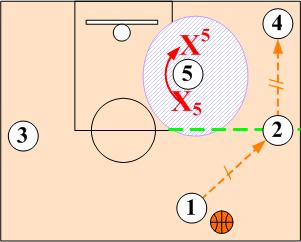
“Go Behind”
Release contact by stepping back. Change "Stop Signs" by circling behind the post. Use this method primarily against non-players or good offensive rebounders.
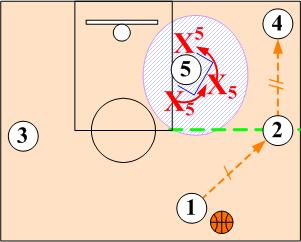
“Face”
Stay tight in a chest to chest position with both hands up high. Pressure the opponent into the lane.

Helpside Strike Position
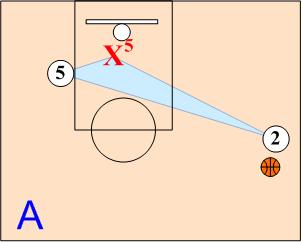
When the ball is on a wing, the weakside post defender assumes a Helpside "Strike" position ready to help out teammates, double team, deny flash cuts and rebound.
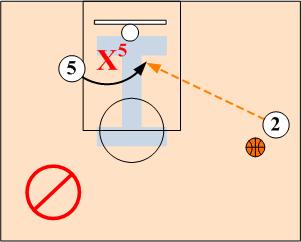
Weakside post defenders must anticipate all cuts into the three second area.
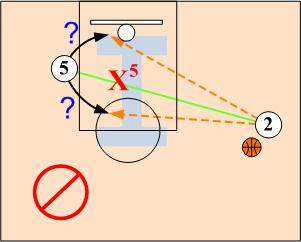
Dictate direction on cuts. Do not give the cutter any options. Helpside defenders should assume a position that forces the opponent to cut in front in order to receive a pass.
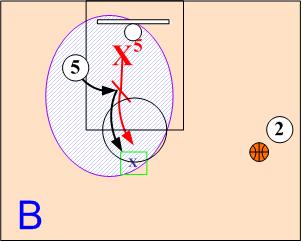
If the weakside post should flash to the ball, the defender must step up and physically block the cut maintaining a low "Ear on Chest" position and force the opponent to the top of the circle pushpoint.

Guarding the Post with the Ball
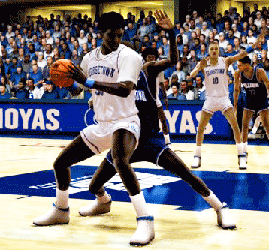
Once the post receives the ball with their back to the basket, the defender should step back to prevent the post from executing a hook step for a power layup. Playing off will also make it more difficult to make a pass to the weakside or to a player cutting to the basket. When the post does turn and face the basket, the defender should immediately step up and "Jam or Smother" the post with knees bent, influencing post to the nearest pushpoint. Should the post try to back down the defender with the dribble, the defender should resist with an elbow high forearm in back and force the opponent to their weak hand. Peripheral defenders should also sag off and steal or deflect the dribble.

Providing Post Support
Post defense requires a total team effort. In football, no matter how good the defensive backs, if a passer is given time, they will eventually find an open receiver. The same is true in feeding the post. The player guarding the passer must have active hands and exert maximum pressure, much like a blitz in football. Helpside defenders must sag off and provide strong back side support making it difficult for the passer to feed the post. Also, use teamwork to influence the ball away from and to trap a really good post player.
Ball Pressure & Helpside Support
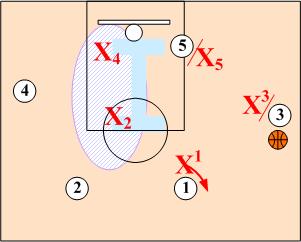
- Pressure all passers so that they are unable to make a good post feed. Try to force passers into dribbling.
- Players away from the ball must assume Helpside I positions and provide strong back side help.
- Prevent ball reversal.

“Post Lob”
When the wing makes a lob pass into the post, the low post’s defender assumes a tight, full chest, face position with both hands held up high. The low helpside defender rotates over to take a charge or double team.
Influencing Ball Away from a Good Post Player
In most cases good offensive post players have one solid “Go To” move, and prefer to set up on one side of the basket. Therefore, defensively, you want to influence the ball away from that side of the floor and force them to operate from their weakest side.
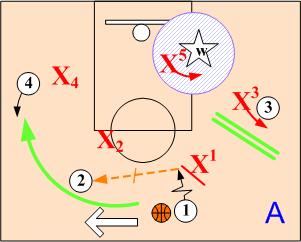
To influence the ball away from good post player, the player guarding the ball should force the dribbler toward the opposite side of the court while preventing any dribble penetration into the three second area. Weakside defenders should sag off and allow reversal passes to be made.
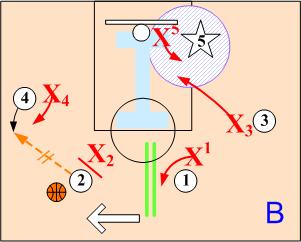
Once a reversal pass is made, defender X1 aggressively denies any return pass keeping the ball on the side away from the post. Wing defender X3 assumes a helpside I position.

Post Traps & Disruptions
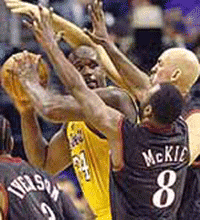
The importance of individual post defense cannot be over emphasized. However, sound individual post defense can be augment with post traps at times to insure total disrupt of the inside post up game. Fronting, Base Go Trap, Go Top, Wing Go, Holding, 2-3 Zone, and Diamond & One combination defense, all provide strategic weapons to combat a strong post up game.
Seven Effective Ways to Disrupt a Strong Post Up Game

POST FRONT
Fronting the post is the primary way to disrupt the low post.

"BASE GO" POST TRAP
Most used post double team option.

"GO TOP" POST TRAP
Used when low post has tendency to turn into the middle.

"GO WING" POST TRAP
Used when post passer is a poor outside shooter.

POST HOLD
Used when opponent has multiple good outside shooters.

2-3 ZONE
Used to double team low post out of a zone defense.

DIAMOND & ONE
Good combination defense to double team low post.
 Low Post Disruptions
Low Post Disruptions

Defending the High Post
Defenders should assume an aggressive pass denial position on ball side. Stay low "Ear on Chest" with hand (STOP SIGN) extended out in the passing lane. Keep back foot 12" behind opponent's foot. Be alert to the over the top lob pass.
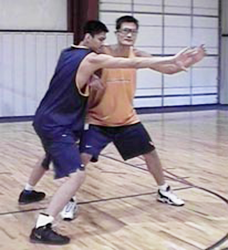
1. Maintaining Ballside Denial
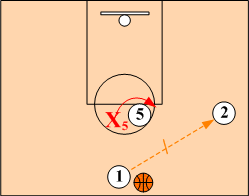
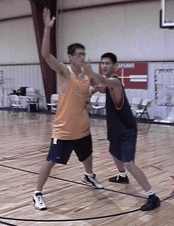
When changing sides on the high post, the defender should move behind to prevent the high post from rolling to the basket for an easy shot. When the ball is below the free throw line extended, assume a pass denial position on the baseline side. Be aggressive and attack the passing lane.
2. Drop Off & Defend the Pass
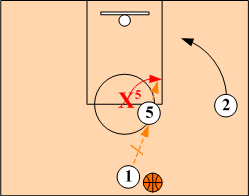
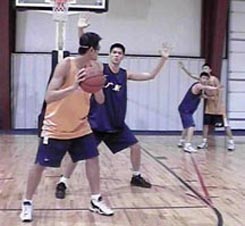
When the high post receives the ball with their back to the basket, the defender should immediately step off (arms length) and play the passing lane.
3. Step Up & Jam the High Post
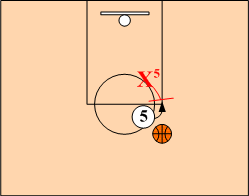
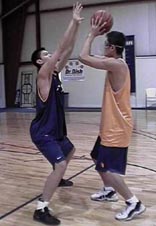
When the high post turns and faces up to basket, immediately step up and 'Jam' the high post player. Take away the pass and shot options and force the high post to put the ball on the floor.
4. Corner Push
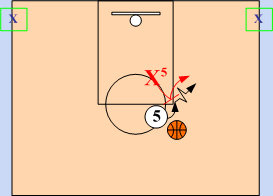
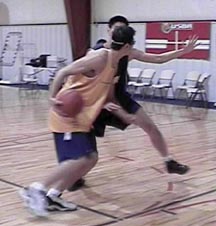
If the high post puts the ball on the floor and drives to the basket, the defensive player forces the dribbler to the corner pushpoint. Use knees apart push steps in a low "Nose on Chest" position. Keep the lead hand extended on the ball.

Defending High/Low Post Feeds
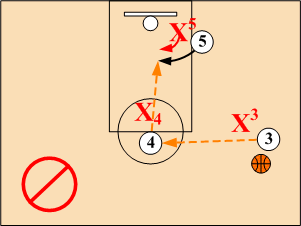
When the opponent has two offensive posts, they will invariably try to employ a high/low attack in an effort to get the ball inside to an active low post player. Since the high post feed comes from the middle of the court (Red Zone), it eliminates all defensive help isolating the low post one on one. If the high post can shoot from the outside it adds to the High/Low's effectiveness. Therefore, this high/low alignment can cause severe problems if not defended properly.
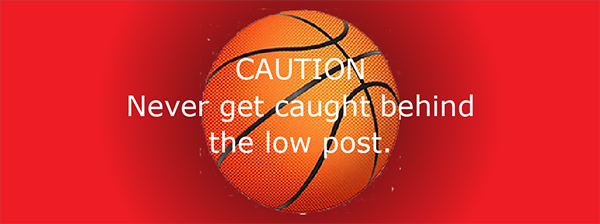
High Post Defense Action
>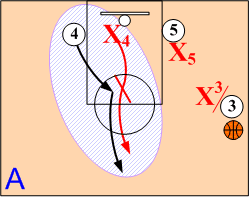
Deny Flash
When the post breaks up to the high post area from the weakside, the defender must physically block the cut and assume a strong first pass denial position forcing the cutter toward the top of the circle pushpoint.
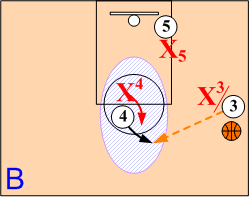
Force Out
The high post defender must deny or disrupt any pass into the high post area by forcing the high post to step out away from the basket to receive the ball. This will lengthen the pass distance to the low post allowing the low post defender more time to adjust their pass denial position.
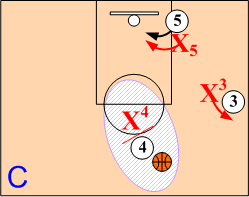
Jam Passer
If the high post receives a pass, the defender must immediately step up and crowd the high post taking away the shot and pass options forcing the high post into dribbling.
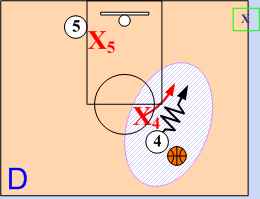
Push Corner
When the high post does puts the ball on the floor, the defender must push the dribbler towards the corner pushpoint, protecting the elbow and block. NOTE: Ball side perimeter defenders must maintain strong pass denials preventing any kick out pass for open spot-up shots.
Low Post Defense Action
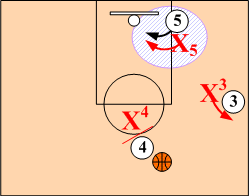
Aggressively front the low post or assume a strong 3/4 pass denial position extending hand in passing lane. Do not get trapped behind the low post.
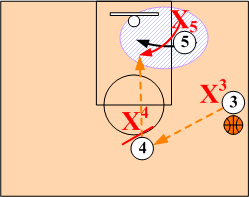
On ball reversal from the wing to the high post, since the defender is playing on the baseline side of the low post, it is much more difficult task for the defender to maintain a strong pass denial position and avoid getting sealed off. The low post defender must be determined and aggressive (physical) changing their position to a full front or 3/4 denial as the ball is being passed from the wing to the high post. If they are late in changing their position, they will invariably get caught behind.
Defending the Lob Pass
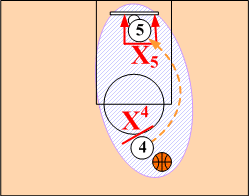
In defending against a lob pass, it is important that the high post defender force the high post to step out to receive the ball, and then to apply pressure on the passer with active hands. When the low post defender is fronting, they must maintain a bent knee position and pushing the low post behind the backboard. The bent knee stance will also allow them to jump higher. If unable to defend the passing lane, the defender should turn and face the low post with both hands extended high.
Making a good lob pass into the post is difficult. However, by applying pressure to both the passer and the receiver, it even makes it more difficult.
Defending High Post Rolls
Anytime the ball is passed into the low post, the high post defender must anticipate that the high post will roll to the basket.
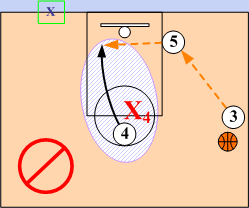
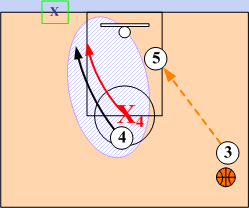
When the low post receives the ball, the high post defender must be alert to the high post's cut to the basket and disrupt it by using a shoulder to shoulder pass denial drop forcing the cutter to the baseline pushpoint on the weakside. If the high post gets past the defender, the defender should then switch "Stop Signs" maintaining a strong pass denial position.
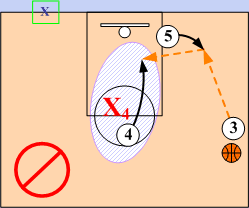
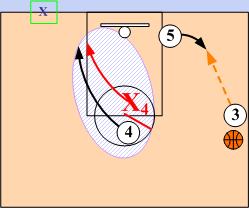
If the low post steps out to the short corner to receive a pass, the high post defender must physically block the high post roll and force the cutter to the baseline pushpoint on the weakside maintaining a strong, shoulder to shoulder pass denial position.

Defensive Post Transition
An often times over look part of post defense is getting back in transition. Transition is not an easy task for the posts. On turnovers and missed shots they must sprint the length of the court. If their opponent rebounds, they must disrupt the outlet pass. After defending the basket, they must defend either the low post area or make a quick close outs to a trailer.
Good transition defense really starts with good offense. When players take good care of the ball and take good shots along with strong offensive rebounding and defensive balance, it makes it difficult for the opponent to push the ball. However, do not do not leave defensive transition up to chance.
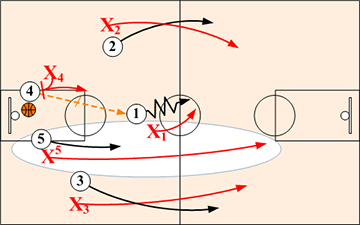
Sprint to Basket
CAUTION: Never trot back on defense with your back to the ball.
On all turnovers or missed shot rebounds, posts must sprint back on defense seeing the ball at all times by looking over shoulder. Watch the ball handler's eyes. Almost all passers telegraph their passes.
Never run back on defense with the opponent. By sprinting to the basket, it provides a numerical advantage for the defense.
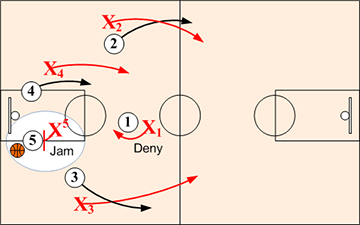
Disrupt the Outlet Pass
"There is nothing worst than turning the ball over on an outlet pass."
However, do not leave this up to chance. On missed field goal and free throw attempts "Jam" the rebounder by immediately applying disruptive pressure to the rebounder with both hands up. This either forces a turnover on the outlet pass or slows the ball handler down in the back court negating any quick push ups or long passes into the front court area.
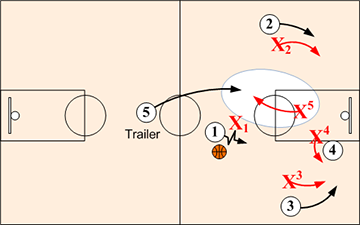
Defending a Trailer
Sprint back to the basket and then close out on a trailer. Defend the basket first and then close out quickly taking away the middle.
Be on balance with both hands up using small, quick "chatter" steps to stop. Maintain a low "Nose on Chest" position forcing the ballhandler toward a sideline or baseline pushpoint. Stay down. Do not try to block the shot or ever run past the shooter.

Attacking High Post Screens
The majority of time, when an opponent assumes a high post position it is primarily for setting screens. Since On Ball screens can produce a variety of quick hitting options, they pose a real threat to any team that is not prepared to defend them. Defenders must be able to recognize and aggressively attack all On Ball screens. Teams can deploy players setting On-Ball screens in the following ways: screens only (usually a non-shooter), screens and rolls to the basket (size mismatch), screens and pops out (usually a shooter), fakes the screen and cuts away to basket (active, triple threat).
Types of "On Ball" Screens to defend include: Mid Screen, Side Screen, Horns (Double Mid Screens), Tandem Side Screens, and Dribble Handoffs (Weave). The defender should deny or disrupt any attempt of the high post to set an On-Ball Or Off-Ball screen. However, when an On-Ball screen is set, the defense can combat it by using one of the seven (7) on ball screen scenarios.
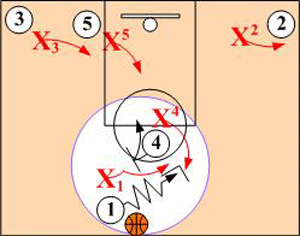
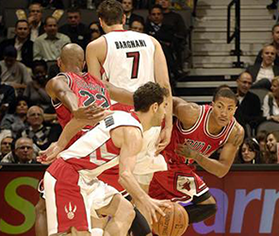
Seven Ways to Effectively Attack "On Ball" Screens
Attacking "On Ball" screens requires communication, teamwork, and enthusiasm. The following seven defensive tactics can be used in disrupting On Ball screens no matter where they occur on the court:

PREVENT
Force the ballhandler in a direction away from the screen.
Completely eliminates the "On Ball" screen

JUMP SWITCH
Aggressively switching, not allowing ball reversal. Double team the roll.
Use when ballhandler is shaky or screener is offensive threat.

TRAP
Double Team the ballhandler coming off the screen. Low "Helpside I" defender rotates over to take away roll option.
Use when ballhandler is a big offensive threat.

TRAP EARLY
Double team ballhandler before the screen takes place.
Use when both ballhandler & screener are offensive threats.

SHOW & RECOVER
Hedge and fight over the screen.
Use when both ballhandler & screener are offensive threats.

SHADOW (Zone)
Screener's defender sags off and assumes a support position.
Use when ballhandler is a penetrator and screener is not an outside threat.

JAM
Jam or disrupt the screener and go under the screen.
Use when ballhandler is not an outside threat.
Game Time Strategies & Deployment
Fortunately, players will not be expected to execute all the different ways to disrupt On Ball screens during a game. In fact, normally only one or two of the options will be deployed according to the coach's decision based on the specific opponent's strengths and weaknesses.
However, these options are subject to change during the course of a game. Therefore, to be successful in attacking and disrupting On Ball screens, they must be constantly analyzed during the game as to why and how they are being set. Once analyzed, the defense can take the initiative, and readily attack it.
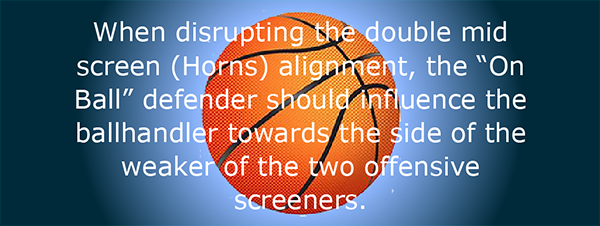
 Attacking "On-Ball" Screens
Attacking "On-Ball" Screens
Push the Ball
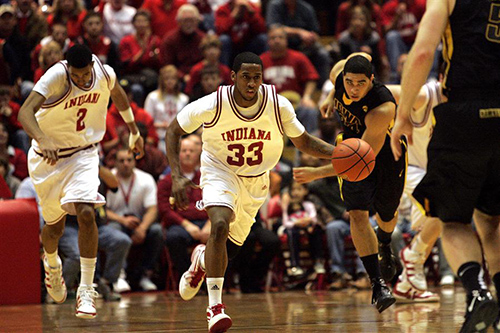
When a turnover does occurs or when a bad shot is forced during an On Ball screen situation, it usually triggers a fast break opportunity that can lead to an easy transition basket.

In Review
Being able to defend the post area is crucial in basketball. Post defense is not just limited to the tallest players on a team. Post defense is played before the post receives the ball, not after. All attempts should be made to prevent the offensive post from receiving the ball.
In General- There are three basic post areas to defend: Low post, Medium post and High Post.
- The defender should beat the offensive post to the "spot" and force the opponent to adjust and set up out of their normal set up position.
- Defend with agility and quickness rather than strength.
- Pressure all passers so that they are unable to make a good post feed.
- Strong post defense requires a team effort.
- How best to defend the post will vary from player to player and game to game.
Low Post
- The defender must be determined to aggressively deny all post passes.
- Post defenders should assume an aggressive pass denial position on ball side keeping their back foot 12" behind opponent's foot.
- When changing defensive post position, the defender must move while the ball is in the air.
- Influencing ball away from an outstanding post player.
- Sound individual post defense can be augment with post traps at times to insure total disrupt of the inside post up game.
- When the post sets up on the weakside, post defender assumes a Helpside "Strike" position alert to deny any flash cuts to the ball.
High Post
- When defending the high post area, defenders should assume an aggressive 3/4 pass denial position on ball side forcing the high post to step out to receive the ball.
- When the high post receives the ball with their back to the basket, the defender should step off (arms length) and play the passing lane.
- When the high post turns and drives to the basket, the defensive player should force to a corner pushpoint.
High Post Screens
- The majority of time, when an opponent assumes a high post position it is primarily for setting screens.
- Since On Ball screens can produce a variety of quick hitting options, they pose a real threat to any team that is not prepared to defend them.
- Attacking "On Ball" screens requires communication, teamwork, and enthusiasm.
- Seven (7) different tactics can be used in disrupting On Ball screens no matter where they occur on the court

Drills for Skills
Like their offensive counterparts, individual defensive skills must be broken down, practiced and refined on all levels of the game. Select desired drill below to View and/or Print:
Defensive Team Breakdown Drills - Click Here
Return to Player Development - Click Here
Return to Defensive Strategies - Click Here
Return to HoopTactics - Click Here
© 2026 HoopTactics All Rights Reserved.
